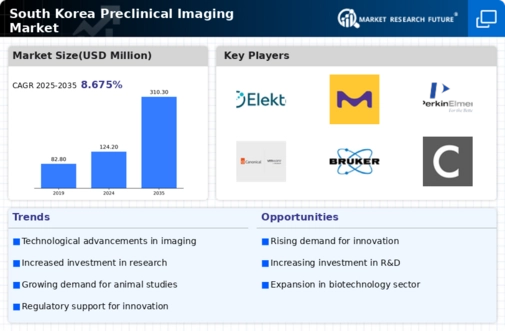Emerging Applications in Disease Modeling
Emerging applications of preclinical imaging in disease modeling are reshaping the landscape of biomedical research in South Korea. Researchers are increasingly utilizing imaging technologies to study complex diseases, such as cancer and neurodegenerative disorders, in animal models. This trend is driven by the need for better understanding of disease mechanisms and the development of targeted therapies. The preclinical imaging market is expected to grow as these applications gain traction, with an anticipated increase in market size by 10% over the next five years. This evolution highlights the critical role of imaging in advancing medical research.
Rising Demand for Non-Invasive Techniques
The preclinical imaging market in South Korea experiences a notable surge in demand for non-invasive imaging techniques. Researchers and pharmaceutical companies increasingly prefer methods that minimize animal suffering while providing accurate data. This shift is driven by ethical considerations and regulatory pressures, leading to a growing adoption of modalities such as MRI and PET. The market is projected to expand as these technologies become more accessible and affordable, with an estimated growth rate of 8.5% annually. This trend indicates a significant transformation in research methodologies, emphasizing the importance of humane practices in preclinical studies.
Collaboration Between Academia and Industry
The preclinical imaging market benefits from increasing collaboration between academic institutions and industry players in South Korea. Partnerships facilitate the exchange of knowledge and resources, driving advancements in imaging technologies. Universities are often at the forefront of research, while companies provide the necessary funding and infrastructure. This synergy is expected to yield innovative imaging solutions, enhancing the overall quality of preclinical studies. As a result, the market may witness a compound annual growth rate (CAGR) of around 7% over the next few years, indicating a healthy ecosystem for research and development.
Growing Focus on Drug Development Efficiency
Efficiency in drug development processes is becoming a critical driver for the preclinical imaging market in South Korea. As pharmaceutical companies strive to reduce time-to-market for new therapies, the integration of advanced imaging techniques is essential. These technologies enable real-time monitoring of drug efficacy and safety in preclinical models, streamlining the research process. The market is likely to expand as organizations recognize the value of imaging in accelerating drug discovery, with projections suggesting a growth rate of 6% annually. This focus on efficiency underscores the evolving landscape of pharmaceutical research.
Increased Investment in Research and Development
Investment in research and development (R&D) within South Korea significantly influences the preclinical imaging market. The government and private sectors are channeling substantial funds into biomedical research, fostering innovation in imaging technologies. In 2025, R&D expenditure in the life sciences is expected to reach approximately $5 billion, reflecting a commitment to advancing healthcare solutions. This influx of capital is likely to enhance the capabilities of imaging modalities, leading to improved diagnostic accuracy and efficiency in preclinical studies. Consequently, the preclinical imaging market is poised for robust growth as new technologies emerge.






















Leave a Comment